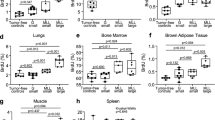Summary
Transglutaminases with different functions and tissue distribution patterns can be distinguished by specific antibodies and by inhibition of enzyme activity in the presence of guanosine triphosphate (GTP). The most common form is the so-called tissue-type transglutaminase that is apparently involved in membrane, stabilization processes, e.g. during apoptosis, and can be inhibited by incubation with GTP at low calcium concentrations. A secretory transglutaminase that cannot be inhibited by GTP is synthesized in an androgen-dependent manner in the dorsal prostate of the rat, the site suggested to represent the origin of the Dunning tumor used as an experimental model in prostate cancer research. Here we studied the expression of transglutaminases in different Dunning tumor lines — mainly in the highly differentiated H subline - and characterized the enzyme both biochemically and immunocytochemically. A very high enzyme activity was found only in the less well differentiated HI-F tumor line. Immunohistochemical reactions and Western blot analysis showed that there is no secretory transglutaminase present in any of the Dunning tumor lines studied. Transglutaminase activity of the Dunning tumor results from the so-called tissue-type enzyme that is nonorgan specific. The absence of a secretory form of transglutaminase does not suport the contention of a prostatic origin o the Dunning tumor.
Similar content being viewed by others
References
Achyuthan KE, Greenberg CS (1987) Identification of a GTP-binding site on guinea pig liver transglutaminase: role of GTP and calcium ions in modulating activity. J Biol Chem 262:1901–1906
Aumüller G, Hartley-Asp B, Seitz J (1989) Differential reaction of secretory and non-secretory proteins in hormone-treated Dunning tumor. Prostate 15:81–94
Aumüller G, Gröschel-Stewart U, Altmannsberger M, Mannherz HG, Steinhoff M (1991) Basal cells of H Dunning tumor are myoepithelial cells: a comparative immunohistochemical and ultrastructural study with male accessory sex glands and mammary gland. Histochemistry 95:341–349
Barnes RN, Bungay PJ, Elliot BM, Walton PL, Griffin M (1985) Alterations in the distribution and activity of transglutaminase during tumor growth and metastasis. Carcinogenesis 6:456–463
Birckbichler PJ, Upchurch HF, Patterson MK Jr, Conway E (1985) A monoclonal antibody to cellular transglutaminase. Hybridoma 4:179–186
Bradford M (1976) A rapid and sensitive method for the quantitation of microgram quantities of protein utilizing the principle of protein-dye binding. Anal Biochem 72:248–254
Camus L, Gley E (1897) Notes sur quelques faits relatifs à l'enzyme prostatique (vésiculase) et sur la fonction des glandes vésiculaires. CR Soc Biol (Paris) 48:787–790
Dunning WF (1963) Prostate cancer in the rat. Monogr Natl Cancer Inst 12:351–369
Fesus L, Thomazy V, Falus A (1987) Induction and activation of tissue transglutaminase during programmed cell death. FEBS Lett 224:104–108
Goebel HW, Rausch U, Steinhoff M et al. (1992) Arguments against the prostatic origin of the R-3327 Dunning H tumor. Virchows Arch [B] 62:9–18
Graham RC, Karnovsky MJ (1966) The early stages of absorption of injected horseradish peroxidase in the proximal tubules of mouse kidney: ultrastructural cytochemistry by a new technique. J Histochem Cytochem 14:291–302
Hand D, Elliott BM, Griffin M (1987) Correlation of changes in transglutaminase activity and polyamine content of neoplastic tissue during the metastatic process. Biochem Biophys Acta 930:432–437
Isaacs JT, Isaacs WB, Feitz WFJ, Scheres J (1986) Establishment and characterization of seven Dunning rat prostatic cancer cell lines and their use in developing methods for predicting metastatic abilities of prostatic cancers. Prostate 9:261–281
Romijn JC, Verkoelen CF, Schroeder FH (1989) Analysis of transglutaminase activities in prostate cancer cells: relationship with metastatic potential. Urol Res 17:331 (abstr 20)
Seitz J, Keppler C, Hüntemann S, Rausch U, Aumüller G (1991a) Purification and molecular characterization of a secretory transglutaminase from coagulating gland of the rat. Biochim Biophys Acta 1078:139–146
Seitz J, Keppler C, Hüntemann S (1991b) Purification and characterization of transglutaminases from the genital tract of the male rat. J Chromatogr 587:55–60
Smolev J, Heston WDW, Scott WW, Coffey DS (1977) Characterization of the Dunning R-3327-H prostatic adenocarcinoma: an appropriate animal model for prostatic cancer. Cancer Treat Rep 61:273–287
Sternberger LA, Hardy PH Jr, Cuculis JJ, Meyer HG (1970) The unlabeled antibody enzyme method of immunohistochemistry: preparation and properties of soluble antigen-antibody complex (horseradish peroxidase-antihorseradish peroxidase). J Histochem Cytochem 18:315–333
Towbin H, Staehelin T, Gordon J (1979) Electrophoretic transfer of proteins from polyacrylamide gels to nitrocellulose sheets: procedure and some applications. Proc Natl Acad Sci USA 76:4350–4354
Tuohimaa P, Goebel HW, Rovio A, Westphal H, Zhao GQ, Aumüller G (1992) Steroid receptors in H tumor, mamma and prostate. Expression of steroid receptors in rat H Dunning tumor: comparison to rat dorsal prostate and mammary gland. In: Isidori A, Fabbri A, Dufau ML (eds) Serono symposia publications, Raven Press, New York (in press)
Wilson E, Viskochil DH, Bartlett RJ et al. (1981) Model systems for studies on androgen-dependent gene expression in rat prostate. In: Murphy G, Sandberg A, Karr J (eds) The prostatic cell: structure and function, part A. Liss New York, pp 351–380
Author information
Authors and Affiliations
Rights and permissions
About this article
Cite this article
Wunsch, A., Rausch, U., Seitz, J. et al. Tissue-type transglutaminase expression in the Dunning tumor. Urol. Res. 21, 9–15 (1993). https://doi.org/10.1007/BF00295185
Received:
Accepted:
Issue Date:
DOI: https://doi.org/10.1007/BF00295185




